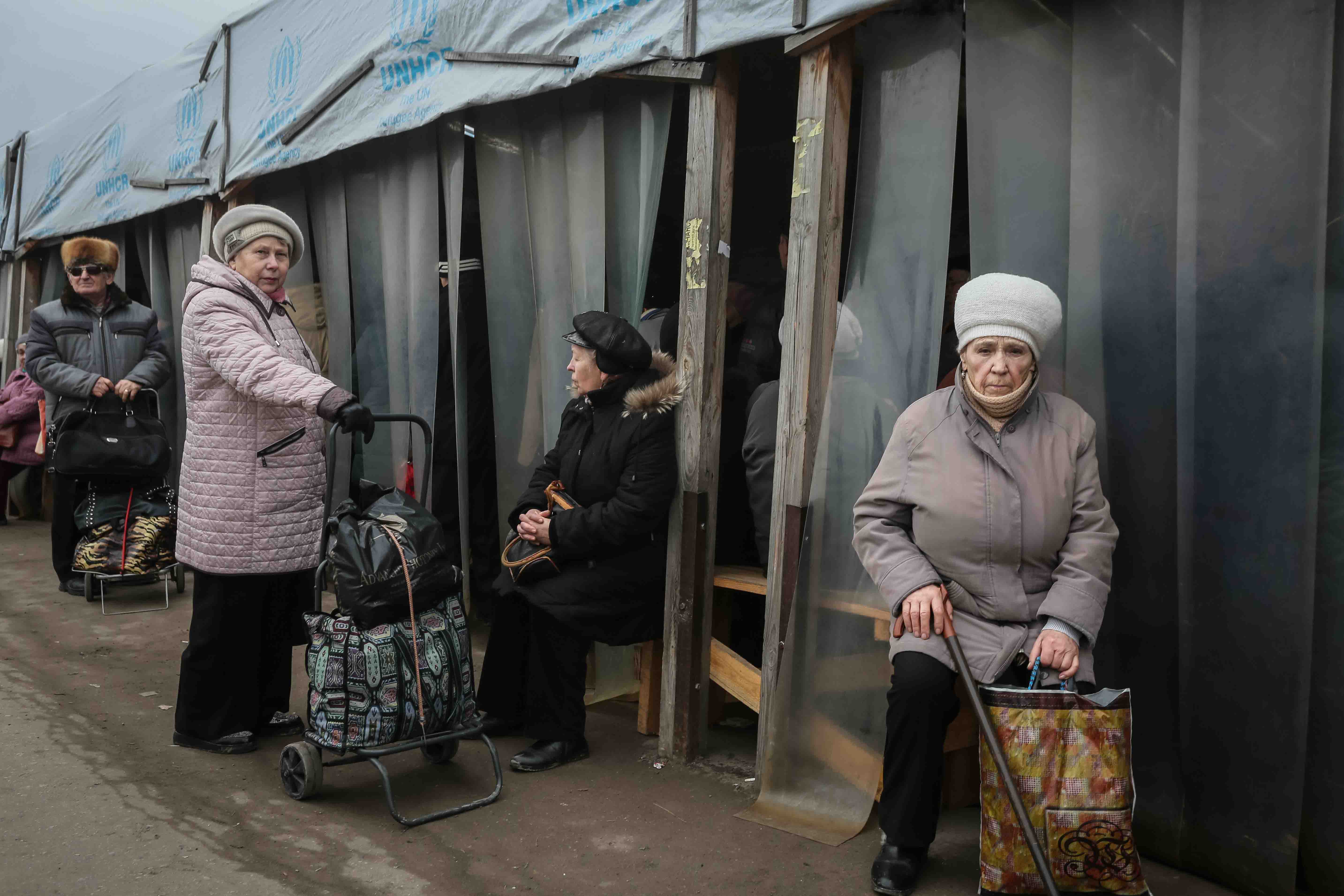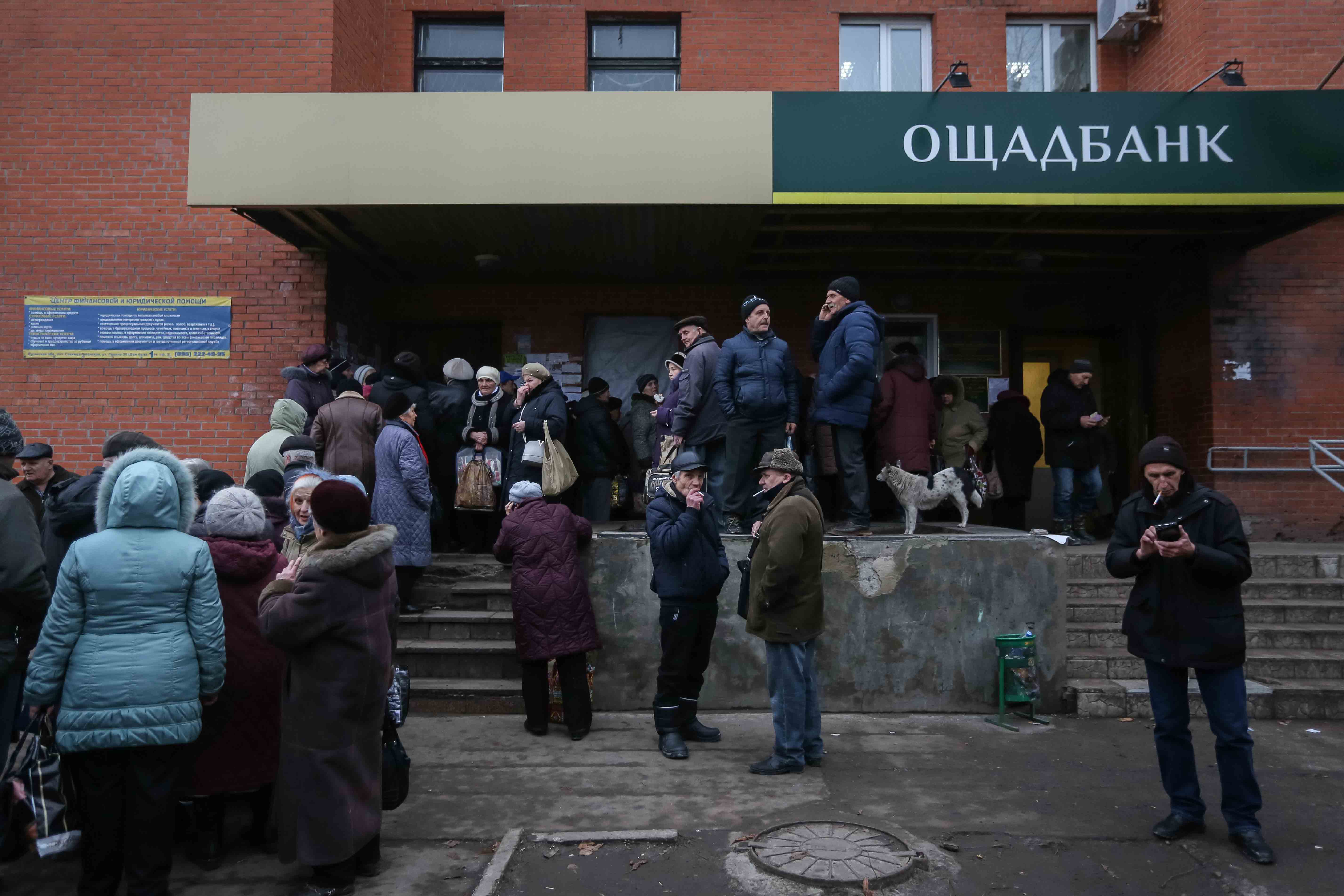STANYTSIA LUHANSKA, Ukraine — When a border guard allows passage, dozens of mostly elderly people run one after another, trying to be the first to reach the beginning of the next line. They occasionally hit each other and sometimes fall down.
But this is not a place for sentimentality.
People hurry to complete the 1.5 kilometer-trip across the partly destroyed bridge over the Siversky Donets River, which connects government-controlled Stanytsia Luhanska, some 770 kilometers from Kyiv, and Russian-occupied Luhansk.
Up to 80 percent of residents lining up there are elderly people who live in the Russian-occupied area but regularly travel to the government-controlled side to collect their pensions or to do paperwork to keep receiving them.
“I usually need some 10 days to recover after this travel,” said Halyna Ivanivna, 76, a former engineer and now pensioner. She spent three hours lining up at the checkpoint.
The woman travels once per month from her native Luhansk city to Stanytsia Luhanska to get her monthly pension of some $74, and to buy her medication on government-controlled territory.
The Kyiv Post has concealed her last name because she might lose her payments if officials discover she lives in the Russian-occupied area.
Halyna Ivanivna said her relatives tell her to stop the tiring travels but it’s a matter of principle for her.
“I worked for 44 years, this is my money,” she said.
See the photo gallery from Stanytsia Luhanska here
Cuts of payments
In August 2014, the government stopped pension payments in the Russian-occupied territory and called on the residents living there to migrate to the government-controlled zone to continue receiving the payments.
But the majority of pensioners who lived there chose to either stay at home despite the war or briefly left their houses and later returned there because they couldn’t afford to pay rent for the new apartments.
Instead, hundreds of thousands of them registered as internally displaced persons to keep on getting their pensions while living in the Russian-occupied areas.
In early 2016, the government imposed additional levels of verification for the social payments for internally displaced persons, claiming that the pensioners living on the Russian-occupied part already receive their pensions from the Russian-backed separatist authorities.
Now, the pensioners have to pass regular verification checks at branches of state-run Oshchadbank, and also be present at a place of registration when government representatives come to verify them without prior notice. The finance ministry additionally verifies the information they provide, while the State Border Service and State Security Service check if a person stays for more than 60 days in the non-government controlled territory, which is also ground to suspend a pension.
As a result of this, the number of war zone residents who managed to keep their pensions decreased more than by half from 1.2 million in 2014 to 504,900 in November 2017, United Nations statistics show.
Most of the remaining pensioners are fake internally displaced persons, registered in towns close to the checkpoints in the government-controlled area, which is not a secret for the government officials.
“There are 10,000 internally displaced persons registered in Stanytsia (Luhanska). But in fact, only 1,000 of them live there,” George Tuka, deputy minister on the temporarily occupied territories said at a press conference in November.

People stand in line for crossing a checkpoint as they go from the non-government controlled territory on Dec. 14 in Stanytsia Luhanska. (Oleg Petrasiuk)
Hours of humiliation
Luhansk Oblast pensioners are especially unlucky because they have only a pedestrian checkpoint leading to the government-controlled area.
Wearing grim faces, they either stand in long lines or walk along the windy bridge.
Cheerful folk music, provided by the local state administration, plays from the speakers interrupted by announcements about the work of the checkpoint.
Summer is the hardest time for the elderly since walking or standing in long lines under the heat kills some pensioners.
Nine people died mostly of strokes or heart attacks in Summer 2017 at this checkpoint, less than half of the 20 who died in Summer 2016.
Fractures and broken bones are also common at the crossing. On one part of the bridge, people have to climb wooden stairs, a big challenge for the elderly and those with disabilities.
This problem can be solved with money.
Porters take from 100 to 300 Russian rubles (some $2 to $5) to carry a person up or down the stairs, or just $1 to carry a suitcase. It’s also possible to pass the checkpoint without a line by paying the officials Hr 300 (about $10), one resident told the Kyiv Post.
The checkpoint has become a business for many. Dozens of the young men pull for money the handmade carriage either with some elderly people sitting on them or massive bags. Sometimes the porters carry even the coffins.
The border guards say that up to 10,000 residents pass this checkpoint per day, while it was designed for a passage of no more than 6,000 residents daily.
“It looks so horrible, all these lines, all these carriages,” said Halyna Ivanivna, the pensioner. The woman thought when her son tragically died that she would never bear a sorrow close to that. But when the war began, she said, things became even worse.

Pensioners stand in line for the bank to get their social security payments on Dec. 14 in Stanytsia Luhanska. (Oleg Petrasiuk)
Legal consequences
After eventually getting to the cash machine to withdraw her money, Halyna Ivanivna receives a nasty jolt. There are some 30 people waiting in line there.
There are also taxi drivers who offer a drive to the nearest available ATM in exchange for $1.70.
The pensioners hurry. If they don’t cross back to Luhansk by 5 pm when the checkpoint closes, they will be forced to sleep on the chairs of Stanytsia Luhanska’s community center. Another option for those who have to stay in town overnight is to rent a bed in a shared bedroom for roughly $5.5 per night.
The disabled are especially vulnerable here because they can’t travel for regular verifications, even if they live in the government-controlled area.
In December, the humanitarian activists of the Right to Protection non-profit organization had to transport the Oshchadbank officers to the houses of the disabled pensioners in Luhansk Oblast so they could get verified, said Olena Grekova, the organization’s team leader in Severodonetsk.
Many pensioners have to go to court to restore these lost social payments. Some of them die before the money resumes being paid.
The pensioners and their heirs may also claim their payments in international court and have high chances to demand and win moral damages, Noel Calhoun, Deputy Representative of the UN Refugee Agency, told the Kyiv Post.
“People have a right to those pensions. It is considered a property right under international law,” she said. “If Ukraine doesn’t pay them now, it will have to pay them later.”
